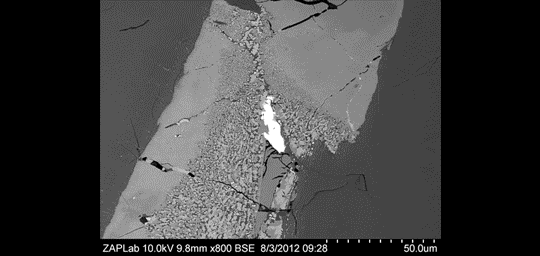
The ZAPLAB where discovery is a matter of time
Time is an essential parameter for the inquisitive human mind, and U-Pb geochronology of natural materials is the benchmark method for the measurement and calibration of "Deep Time" - the immense span of events within which our solar system, planet and species has evolved. Microminerals such as zircon, though less than the width of a human hair, are the ultimate 'survivor crystals', and can encapsulate a wealth of unique information on the relative age and nature of processes that have shaped our environment - from the precise timing of a modern volcanic eruption to the establishment of water on a planet four billion years ago.
At the ZAPLab, our philosophy is that the accurate interpretation of age and other information from microminerals hinges on the detailed measurements of their orientation and chemical microstructure - an approach that identifies the areas of the microcrystals that have preserved the original chemical composition and crystal orientation, as well as those that have been altered, and prone to chemical exchange during later events, such as mountain building or meteorite impact.
We accomplish this by geolocating targets within a sample on a GIS platform, and then using electron nanobeam techniques to reconstruct an event sequence or 'Huttonian geochronology' experienced by the mineral and its host rock. Integration of this information with U-Pb isotopic dating enables disentanglement of otherwise hidden processes of planetary evolution, as recently demonstrated by our group and collaborators regarding the crust of Mars (Moser et al., Nature 2013)
At our facilities, we are able to able to analyse minerals in-situ, as well as extract and process microminerals such as zircon, titanite, rutile, apatite, allanite, and baddeleyite, through techniques including electric pulse disaggregation, and electromagnetic and heavy liquid separation, prior to electron nanobeam analyses by FE-SEM (BSE, CL, EDS, WDS, EBSD and STEM). This data may be coupled with high spatial resolution (SIMS, LA-ICPMS, Atom Probe) or high chemical resolution (ID-TIMS; MC-ICPMS) data obtained from our partner facilities, allowing us to quantify the total paragenesis of the targets and their host rock.
Also from this web page:
About
Our Department:
The Department of Earth Sciences
At the University of Western Ontario
ZAPLab In The News:
- Western-led 'international beam team' solves Martian meteorite age puzzle
- Featured in National Geographic's: Alien Fireballs
- New Discovery Of 'Old Growth' Crystals Provides New Record Of Planetary Evolution



